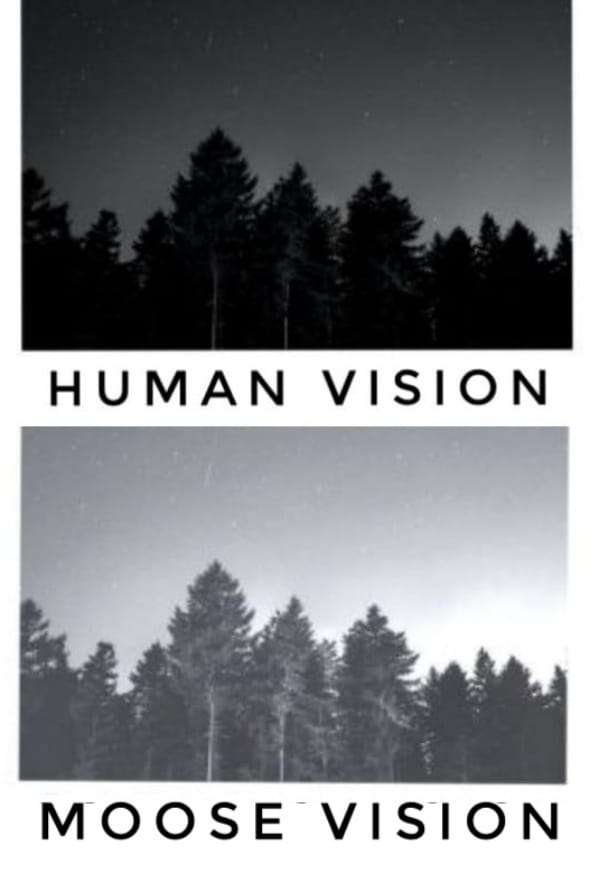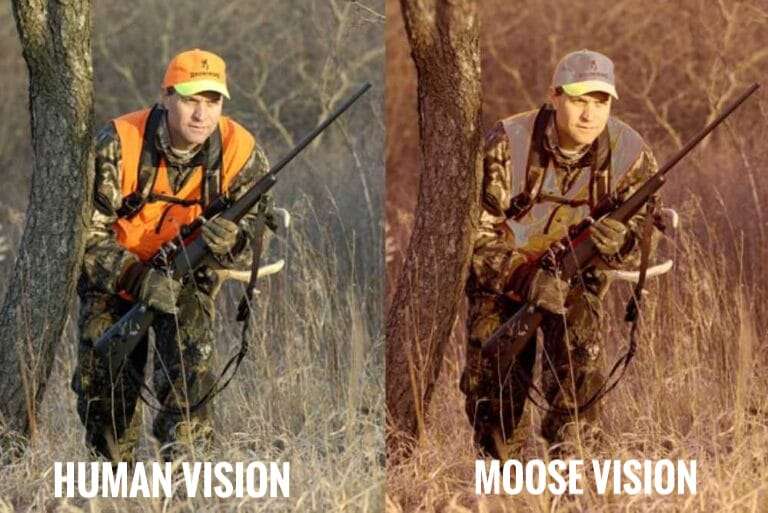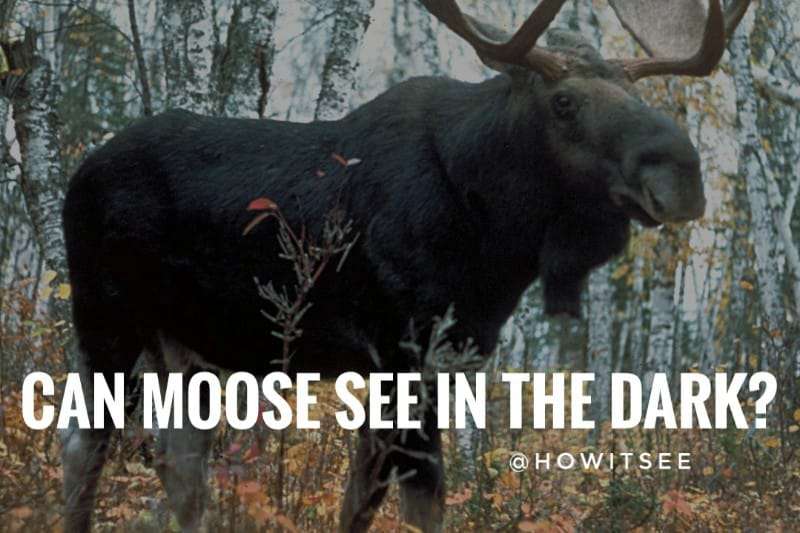Moose, also known as Elk in Eurasia, is the largest species in the deer family that loves to live in subarctic climates. Many peoples have already come across Moose, especially in the North American region.
But have you wondered how these largest deer species see the world, or can they notice in the dark? If yes, then below is the answer.
Moose can efficiently see in the dark. Their eyes have more rods than cones compared to humans helps them to see much better in low-light conditions.
Along with it, they also have tapetum lucidum, a thin reflective tissue that reflects the light on the retina one more time for greater absorption.
The eyes of all deer species will glow if you emit light on them. It exhibits the presence of tapetum lucidum. It grants them superiority over human vision at night.
However, excluding night vision, Moose or elks have bad eyesight, and they perceive the world in fewer colors. Later in this post, we discussed more Moose or Elk vision.
Can Moose See in the Dark?
Like other nocturnal animals, Moose can see much better in low-light conditions. Their eyes predominately focus more on rods, which grants them the ability to glimpse easily in the dark.
Additional information: Rods in the eyes are susceptible and have a photosensitive pigment called rhodopsin that activates even in low-light conditions.
In comparison, cones in the eyes require bright light to activate, which helps to differentiate colors and increase the sharpness of the vision. Moose has more rod-concentrated vision, whereas humans have more cones in their eyes.
However, even Moose or other deer species cannot see in complete darkness. They need at least moonlight or light from the stars to navigate in the deep dark forest.
Also, Moose or elks sometimes depend on their nose and ears to sense the environment better. Below we have attached the difference between human and moose night vision.

Unlike Moose, humans neither have too many rods nor tapetum lucidum to witness at night. That’s why we do not have night vision.
Also, many peoples have queries about not seeing the bright light reflection from moose eyes. It is because they are large animals with eyes on the extreme sides of their heads. Therefore, you have to shine the bright flashlight at a certain angle to see its reflections.
Can Moose See Color? Moose Vision
Yes, Moose can see colors but not in a similar way as we do. They have a dichromatic vision and glimpse the world predominantly in blue, dull yellow, and gray shades. Their eyes are sensitive to small and medium wavelength hues due to the availability of only two kinds of cones.
Unlike Moose, humans are trichromatic, and we have three kinds of cones: S-cones, M-cones, and L-cones. That’s the primary reason we can easily recognize millions of color shades between 380 nm to 720 nm.
Also, Moose/Elks do not have UV filters in their eyes, due to which they can sense ultraviolet light. It also permits them to navigate better in the dark.
Without a UV filter, they can perceive light below 380 nm wavelength, which is impossible for humans. Also, this filter protects our eyes from many harmful radiations of the sun and enhances our vision.
Are Moose Colorblind?
Moose are not entirely colorblind. They see the world in limited colors. Unlike humans, moose are dichromats, meaning they have only two kinds of cones in their eyes that allow them to perceive only small and medium wavelength colors nearly up to 520 nm.

Image Source | North American Whitetail
That’s why they predominantly see the world in blue, yellow, and gray shades. They glimpse all large wavelength hues like red and orange in the shades of gray.
What Colors can Moose not see?
Moose cannot see large wavelength hues like many Secondary and Tertiary colors that are greater than approximately 520 nm.
Due to the absence of L-cones in their eyes, they recognize red, orange, green, pink, etc., hues in the shades of gray or in black and white. In addition, Moose/Elks are not able to distinguish infrared light too.
Do Moose have bad eyesight?
Yes, moose have bad eyesight compared to humans. They are near-sighted and see far-distant objects in a blur without any details.
In accordance with the study, scientists estimated that most deer families have 20/100 vision. “It means the details of the surroundings that deer see at 20 feet is what a normal human can see back to 100 feet.“
Moreover, they have advanced smell and hearing that assists them in sensing the environment much better.
But sometimes, it works against them. It makes them uneasy because they can smell and hear something coming but cannot see it due to being near-sighted.
Can Moose see Red & Green Lights?
No, Moose cannot see the red and green light as humans do, but they can sense green light at night. All deer family has the absence of L-cones, and see they see the large wavelength colors in the shades of gray.
During the daytime, moose recognize green color in yellow shades, but at night its brightness can easily disturb them.
On the other hand, red light is not visible to them due to less brightness; that’s why these lights are considered to be best to spot Moose at night.
Human Vision vs. Moose Vision
| Human Vision | Moose Vision |
| Humans are trichromatic and have all three kinds of cones. | Moose are dichromatic and have only two kinds of cones. |
| We can see millions of color shades. | They can see only blue, yellow, and gray colors. |
| Humans cannot perceive ultraviolet light. | Moose can perceive ultraviolet light. |
| Humans do not have night vision. | Moose have better night vision. |
| We can easily see far-distant objects. | They are near-sighted. |
The question of whether moose or elk have night vision has been the subject of scientific investigation. While these majestic animals possess impressive adaptations for their low-light environments, their visual abilities in complete darkness are limited.
Moose and elk rely heavily on their keen senses of hearing and smell to navigate and detect potential threats during dark hours.
Although they have large eyes that aid in detecting movement and shapes in dim light, their visual acuity in absolute darkness is not as acute as some nocturnal creatures.
Moose and elk do not possess a specialized reflective layer, called the tapetum lucidum, found in the eyes of many nocturnal animals, which enhances their night vision.
Nevertheless, their remarkable ability to navigate through dimly lit environments and their adaptation to crepuscular activity patterns—being most active during dawn and dusk—allow moose and elk to thrive in their natural habitats.
Their survival relies on a combination of sensory adaptations and behavioral strategies that help them overcome the challenges of limited visibility at night.
Here, we conclude our article on “Can Moose See in the Dark” and give a brief overview of Moose or elk vision. We hope you like the post. We will be back with another article. Till then, stay tuned with us and read the articles below.
References:
- Paul Smith: Moose are colour blind – SaltWire
- MOOSE FACTS (PAGE 4) by smouse force9
- Moose Information Page – Wildlife Collision Prevention Program
Also Read:

Meet Abhidept (nickname Monty), the visionary founder of How It See, being an engineering student, he’s fueled by an insatiable curiosity about the world around him. He is captivated by an eclectic correlation between animal groups, science, and nature, and this fascination drives his quest for understanding.
After completing his degree, he’s set on a mission to delve deep into the realm of nature, accumulating knowledge to share with you through his writing. In the meantime, he loves to watch anime and read anime.
